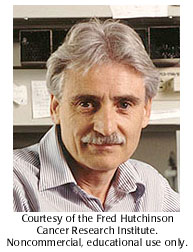Concept 38 Development balances cell growth and death.



 Lee Hartwell was one of the first to use yeast as a model system, and he identified many of the genes involved in the cell cycle. Bob Horvitz and Mike Hengartner used C. elegans to work out the mechanism of programmed cell death. Scott Lowe's research has shown how the regulation of the cell cycle affect cancer.
Lee Hartwell was one of the first to use yeast as a model system, and he identified many of the genes involved in the cell cycle. Bob Horvitz and Mike Hengartner used C. elegans to work out the mechanism of programmed cell death. Scott Lowe's research has shown how the regulation of the cell cycle affect cancer.
Leland Hartwell (1939-)

Lee Hartwell was born in Los Angeles. His father was a sign maker, and Hartwell would help him in his shop after school. Hartwell developed an interest in figuring out how things work, especially electrical gadgets. This natural curiosity did not mean that he was a good student. He did well enough but didn't really get involved with science until after high school.
He was accepted to the California Institute of Technology and initially thought he would study physics. However, he became interested in "DNA" and finished college with a degree in biology. Hartwell then went on to earn a Ph.D. at the Massachusetts Institute of Technology.
After his Ph.D., Hartwell went to the Salk Institute because he wanted to work with Renato Dulbecco. Hartwell already knew he wanted to work on cell division, which was one of Dulbecco's research interests. Despite the cramped conditions — the Salk was a more primitive institute at the time — Hartwell enjoyed his post-doctoral years and learned a lot from his mentors.
Hartwell then accepted an assistant professorship at the University of California, Irvine. He also made the rather risky decision to start using yeast as a model system. Not many people were using yeast at the time, but Hartwell wanted and needed a simpler experimental system to study basic questions of cell growth. Hartwell is a pioneer in yeast genetics, and has used yeast to identify many of the genes involved in protein synthesis as well as the cell cycle.
In 1968, Hartwell moved to the Department of Genome Sciences at the University of Washington and it was there that he did most of the work on cell cycle genes. He stayed at the University of Washington until 1996 when he moved to the Fred Hutchinson Cancer Research Center. His lab is working on the molecular mechanisms that maintain and support gene variations, which can eventually lead to the evolution of new species.
In 1997, Hartwell was appointed President and Director of the "Hutch," now Emeritus, and spends most of his time integrating the basic, applied and clinical effort of interdisciplinary cancer research. In 1998, he won the Albert Lasker Basic Medical Research Prize for his innovative and pioneering work. Hartwell shared in the 2001 Nobel Prize in Physiology or Medicine for his work on defining the cell cycle. In 2003, Washington Governor Gary Locke awarded the Medal of Merit, the state’s highest honor, to Hartwell.
In 2009, Hartwell was appointed Arizona State University’s Chair of Personalized Medicine and co-director of the Biodesign Institute's new Center for Sustainable Health.


The cells that don't undergo programmed cell death in C. elegans often share the same cell fate as their sisters. The extra cells don't seem to have any detrimental effects.

The "extra" cells in C. elegans mutants that don't undergo programmed cell death are often nerve cells. Are these worms smarter?
 DNA is packaged in a chromosome.
DNA is packaged in a chromosome. Higher cells incorporate an ancient chromosome.
Higher cells incorporate an ancient chromosome. Some DNA does not encode protein.
Some DNA does not encode protein. Some DNA can jump.
Some DNA can jump. Genes can be turned on and off.
Genes can be turned on and off. Genes can be moved between species.
Genes can be moved between species. DNA responds to signals from outside the cell.
DNA responds to signals from outside the cell. Different genes are active in different kinds of cells.
Different genes are active in different kinds of cells. Master genes control basic body plans.
Master genes control basic body plans. Development balances cell growth and death.
Development balances cell growth and death. A genome is an entire set of genes.
A genome is an entire set of genes. Living things share common genes.
Living things share common genes. DNA is only the beginning for understanding the human genome.
DNA is only the beginning for understanding the human genome.